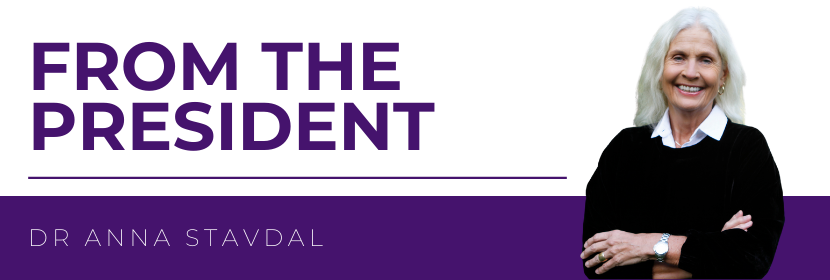From the President: September 2022
 Español Français
Español Français 中文
Visit our World Patient Safety Day 2022 board on Trello
Patient Safety Day, 2022 : Safe Medication!
What is the drug you use with patients all the time?
The doctor is the drug.
Dr. Michael Balint
Yes. Sixty years of studies have validated, repeatedly, that the doctor-patient relationship is a key to the placebo factor – how patients get well. It may represent as much as 30-40% of healing therapeutic responses, regardless of which medical personnel are involved, and including when medication is part of the treatment.
But make no mistake about it: In our field, the prescription pad is one very powerful tool!
We Family Doctors must consider each aspect our Hippocratic Oath in every clinical decision we make: “Preferably cure, often alleviate, always comfort. But, first of all: Do no harm.” Among our more difficult choices to balance are medications: prescribing them for patients, following up on their effects and side-effects, and making decisions about ceasing to prescribe them.
That’s why we at WONCA are so supportive of the selection of “Safe Medication!” as the theme of this year’s annual WHO “Patient Safety Day”.
A bit of background: Launched in 2019 by WHO, the 17th of September each year is now the global “Public Health Day”. Their emphasis is on solidarity and strengthening concerted action worldwide, both among countries and international partners. As quality of care and patient safety are core themes in the Family Doctors’ professional development, it’s natural that WONCA’s Working Party on Quality and Patient Safety has forged such strong links to the WHO Department of Patient Safety in Geneva. We can thank them for leading the way in WONCA`s efforts to contribute to this global campaign.
I recommend that all WONCA members explore what contributions Family Doctors can make toward meeting the four objectives that the WHO has set for “Patient Safety Day, 2022 : Safe Medication! (Just so you know, WONCA’s Secretariat has created a toolkit for addressing these aims.):
Objective 1: RAISE global awareness of the high burden of medication-related harm due to medication errors and unsafe practices, and ADVOCATE urgent action to improve medication safety.
We can look more closely at how we get our information about the medications we choose among, including how prescription guidelines have been devised, how specific they are about their treatment applicability, including within different fields and contexts. The pharmaceutical industry is central here.
Obviously, they also play a major economic role. Funding is crucial to developing new treatments, carrying out research, and distributing research results. But: revenue is a primary goal for Big Pharma. If we’re to be trusted, we physicians at the prescribing end of the process need to help each other catch on to marketing ploys – before we fall for them. We must also sharpen our skills at interpreting research results to protect our patients from harmful drug interactions as well as other potentially negative effects, such as becoming over-medicated. This requires us to trust our clinical experience, especially the individualized knowledge we gather about our patients thanks to the relationships that our commitment to continuity of care helps us build. Results from randomized controlled trials are not necessarily applicable to the patient in front of us!
Objective 2: ENGAGE key stakeholders and partners in the efforts to prevent medication errors and reduce medication-related harm.
Family Doctors work at the community level where they engage with other professionals in Primary Care teams. Important assistance is provided by nurses, community health workers, pharmacists, among others, in the administering of medication, not least to elderly people exposed to polypharmacy. Secondary Care hospital services also prescribe medication. When patients return to their usual environment, be it their home or a nursing facility, the medications initiated during Secondary Care hospital treatments will need to be reevaluated. It serves the Family Doctor well to have established good collaborative relationships with their hospital and community co-workers. An example is when taking a patient off a specific medication that is no longer appropriate. Deprescribing turns out to be much harder than prescribing, often requiring genuine clinical courage. It is far less daunting to make and carry through on such difficult decisions when they’ve been arrived at on the basis of mutual professional assessment.
Objective 3: EMPOWER patients and families to be actively involved in the safe use of medication.
This aim invokes the person-centered nature of Family Medicine. Recommending that someone take a medication every day is actually quite a radical intervention. Patient compliance – whether or not a patient follows our advice – depends also on us. Has the information we’ve communicated been sufficient, and tailored to that specific person right now? Have we made clear what positive effects we expect, as well as potential side effects? Have we also informed the patient what risks – and/or benefits – that might result from not taking the medication? Our patients need to experience that we evaluate each prescription carefully, and trust that we will reassess regularly whether – or not – the medication continues to be useful for them.
Objective 4: SCALE UP implementation of the WHO Global Patient Safety Challenge: Medication Without Harm.
'Better Living Through Chemistry’ was an American advertising slogan the DuPont chemical company came up with in the 1930’s. I’m told it was embraced as a rallying cry for mind-expanding drugs during the cultural upheavals of the ‘60’s and ‘70’s. Yet, from penicillin, to the smallpox vaccine, to stopping the scourge of polio, to slowing deaths by COVID, etc., it has proved prophetic.
Tread carefully, however. We’re all aware of the doctor-assisted opiate addiction epidemic, and the burgeoning crisis of antibiotic-resistance after decades of over-prescribing, and, of course, there’s the anti-vaxx distrust.
We have our work cut out for us to achieve an honest mix: pharmaceuticals in service of our doctor-patient relationships. Not the opposite!